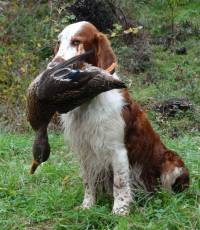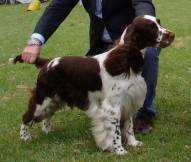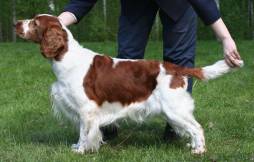English and Welsh Springer Spaniels
 English Springer Spaniel
English Springer Spaniel
The function of all the different breeds of Sporting Spaniels was to flush out birds and other game, causing them to rise, 'start' or take flight. Then the hunter could safely shoot at it. In the case of birds they would rise or take flight. In the case of game, they would start running. Larger Spaniels that used to 'spring' the game into the open were called 'Springing Spaniels or Springers'. However, if the spaniel kept chasing the already moving game like the modern dog pictured chasing the already moving ball, it could be accidentally be shot!
Additionally there is no reason why the English and Welsh Springer Spaniels should be lumped together as though they had some historical or other connection. This is further described in 1872 as follows:
"The decision of the Kennel Club, when they re-organised and re-classified the spaniel breeds into separate varieties to repeat the word 'Springer' as an adjective to both titles was, in retrospect, unfortunate, because it causes a great deal of confusion from time to time and suggests a closer link than actually exists. Springing, or starting, game is the function expected of all spaniels, whatever their official title"[3]
 Working Group of English Springer Spaniels
Working Group of English Springer Spaniels
However, the 'Springer' Spaniels typically worked in more open country than the thick undergrowth for which Cocker, Sussex and Clumber were developed. Formerly called the Norfolk Spaniel, the English Springer is the tallest of seven Land Spaniel breeds in this section and Welsh is the closest to those described in the History of Spaniels 1570 AD. In Australia, English Springers are also the most commonly used Spaniels in today's Field Trials and as rough shooters dogs.
History of the English Springer Spaniel
 English Springer working
English Springer working
Historically the way Spaniels typically worked was flushing and retrieving game contrary to the way Setters worked as outlined in the History of Setters which was to silently crouch, simply locating the prey. As the years rolled by and guns became capable of shooting multiple rounds, the distinction between Setting Spaniels or Setters and Spaniels also became more specific. However, the basically white coat remained preferable when the Norfolk Spaniel gained acclaim as a separate breed. By the mid-1800 it was written:
"For appearance, I prefer Norfolk dogs, which have a pre-ponderance* of liver colour; but for use it is better to have plenty of white, as they are more readily seen."[1] (* Note 'pre-ponderance' means dominance)
 Springer (Early English) 1815
Springer (Early English) 1815
The original name Norfolk Spaniel was because of the notoriety they gained when they were first developed, not because of any geographical place where they developed. The bloodlines were jealously guarded by the gamekeepers of generations of Dukes of Norfolk. In 1902 the Sporting Spaniel Society Club decided to call them 'English Springers other than Clumber, Sussex and Field'. Then the Kennel Club(UK) followed and included the Welsh. Consequently, the Spaniel Separation Saga continued until well into the 1900's while all seven of these Sporting Spaniel breeds each developed their own Breed Type.
The English Springer Spaniel becomes a Pure Breed
 English Springer Spaniel
English Springer Spaniel
The English Springer's separation as a breed began in 1902 after Sir Hubert Fitzherbert publicized them in England with his 'Tissington' strain winning most of the prizes available.However, has been recorded that around 1866 sportsmen of New Jersey, shot over them in the marshes of the Hudson River in USA.
In the first Breed Standard that the English Springer's height at shoulder should be approximately equal to his length from the top of the withers to the root of tail. This immediately separated them from the craze for the short legs that plagued the Field, Sussex and Clumber Spaniels. It is also interesting to note that the colour designated in the first Breed Standard influenced by members of the Sporting Spaniel club who worked these dogs which stated:
"liver and white or black and white (with or without tan)... but the pied colours are preferable, however, as (they are) more easily seen in cover'[2].
History of English Springer Spaniels in Australia
 English Springers 1935
English Springers 1935
The first record of an English Springer being imported into Australia was 'Jacke' a liver and white imported in 1906[4]. There appears no further record until the 1930's when a pair bred by Frank Warner Hill in Tasmania. Then different exports went to Melbourne and founded the 'Gildabrook' Kennels of Mr Fildes who said in his advertisement in 1935:
"All stock guaranteed to be true English Springer... sent on approval anywhere against cash"[5]. It appears this kennel lasted through World War Two as it had four of the 20 entries that competed at the 1947 Royal Melbourne Show.
 Eng Ch Moorcliff Fleetwood Gamecock (Imp UK)
Eng Ch Moorcliff Fleetwood Gamecock (Imp UK)
In 1968 English Springers in Australia were boosted by the importation of English Show Champion Moorcliff Fleetwood Gamecock from UK to Adelaide in South Australia. He won 19 English CC's in England and among his numerous wins here was 5 Best Exhibit in Show including Adelaide Royal and the 'Pal' International. He founded a dynasty which spread throughout Australia, siring Champions for many of our most famous English Springer Spaniel kennels[6].
History of the Welsh Springer Spaniel
 Spaniel (Early Welsh) 1797
Spaniel (Early Welsh) 1797
Arguably the Welsh Springer could be considered the oldest of the Spaniel breeds. In the History of Spaniels, of particular note when describing the early Spaniels, Caius (c 1534) wrote:
"The most part of their skin(s) is white, and if they are marked with and spots, these are commonly red".
Formerly called the Welsh Cocker this dog was also designated as a Springer in 1902 at the same time as the English Springer. However, its colour was always red and white only. Although the Welsh Springer worked springing game in a similar manner to the other English Spaniels, he developed quite separately.
In Australia, Welsh Springers were not as fortunate as their English counterparts and there seems to be no proof of them being registered here until well into the 1970's.
The Welsh Springer Spaniel becomes a Pure Breed
 Welsh Springer Spaniel
Welsh Springer Spaniel
To add to this confusion, the Welsh Springer Spaniel was recognised as a pure breed at the same time as the English Springer when, in 1902 the Kennel Club (UK) Gazette stated: "Additions have been made to the Spaniel classification, English Springers (other than Clumber, Sussex and Field) and also Welsh Springers (red and white) having now been provided for"[3a].
 Welsh Springer Spaniel
Welsh Springer Spaniel
The Welsh Cocker had been kept pure long before this recognition by several families in the large estates of Wales. So this basically white Spaniel with red markings and vine shaped ears has been depicted by many artists and described by many authors for centuries. This is testament to the bloodlines having been so jealously guarded by the gentry in Wales.
Today Welsh Springers are unique with their rich red markings on white coats, hazel eyes, flesh coloured noses and distinctive, vine shaped ears. Let's hope these essential features never lost!
Comparison between the English and Welsh Springer Spaniels
| English Springer | Welsh Springer | |
|---|---|---|
| General Appearance | Highest on leg and raciest in build of all British land Spaniels | Obviously built for endurance and hard work. |
| Size | Height approximately 51 cms (20 ins) | Height for dogs around 48 cms (19 ins) and bitches 46 cms (18 ins) |
| Colour | Liver and white, black and white with or without tan markings | Rich red and white only |
| Coat | Straight and weather resisting with moderate feathering on ears, forelegs, body and hindquarters. | Straight, flat, and dense with a silky texture but not wiry, wavy or curly. Feathering on the forelegs and hindlegs above the hocks should be moderate but light on the ears and tail. |
 English Springer Spaniel English Springer Spaniel |
 Welsh Springer Spaniel Welsh Springer Spaniel |
|
| Skull | The skull is of medium length, fairly broad and slightly rounded with flat cheeks. | The skull is of proportionate length and slightly domed. |
| Stop | The stop is created by the brows which cause a fluting between the eyes which dies away along the forehead towards the occipital bone | The stop is clearly defined. |
| Muzzle | The muzzle is of proportionate length to the skull and well chiselled below eyes. The flews are fairly deep and square and the nostrils well developed. | The muzzle is of medium length and well chiselled below eyes. The flews are straight and fairly square and the nostrils are well developed and flesh coloured to dark brown. |
| Eyes | Medium size and almond shaped but not prominent or sunken or showing haw. The colour is dark hazel but never light. | Hazel or dark and medium size but not prominent, sunken, nor showing haw |
| Ears | Lobular in shape with good length and width, set in line with the eye and fairly close to head. They should be nicely feathered. | Comparatively small and shaped somewhat like a vine leaf, the ears gradually narrow towards the tip. But they are set moderately low and hang close to cheeks but have only light feathering. |
| Mouth | A normal scissors bite | A normal scissors bite |
 English Springer Spaniel English Springer Spaniel |
 Welsh Springer Spaniel Welsh Springer Spaniel |
|
| Neck | Strong and muscular with good length and a slight arch, but without dewlap. | Long and muscular without dewlap |
| Forequarter | The shoulders should be well laid and the forelegs straight and well boned with strong but flexible pasterns. | The shoulders should be well laid and the forelegs straight, well boned and of medium length |
| Feet | Tight, compact and well rounded, with thick, strong pads. | Round, firm and cat like with thick pads. |
| Hindquarter | The hindlegs have broad, well developed muscular thighs a moderate turn of stifle and short hocks. | The hindquarters are strong, wide and muscular with deep second thighs, well boned hindlegs moderately angulated stifles and short hocks that turn neither in nor out |
 English Springer Spaniel English Springer Spaniel |
 Welsh Springer Spaniel Welsh Springer Spaniel |
|
| Tail | The tail should be set low and never carried above level of back. It should have a lively action and feathered in balance with the rest of the dog. | The tail should be set on low and never carried above level of back. It should be lively in action and feathered in balance with the rest of the dog. |
| Gait | Forelegs should swing straight forward from shoulder, throwing feet well forward in a free and easy manner. The hocks should drive well under body, and follow in line with forelegs. At a slow pace, the English Springer may pace or amble. | The Welsh should move with a smooth, powerful, ground covering action, driving from the rear. |
References and Further Reading
Hot off the Press! Jane has just published a book 'Gundogs Unveiled'. Information on our sister website: www.Rangeairevision.com
Also published as Jane Harvey "The Spaniel Separation Saga" in Dog News Australia (Top Dog Media Pty Ltd Austral NSW) Issue 1, 2016 Page 10
[1] 'Idstone' 'The Dog' Published by Cassell, Petter and Galpin London 1872 Chapter XIX The Norfolk Spaniel' Page 149
[2] Colonel R. Claude Cane, 'Cassell's New Book of the Dog' by Robert Leighton assisted by eminent authorities on the various breeds. Published 1907 by The Waverley Book Co Ltd Vol 11, Chapter XXV1 Part V11 the English Springer Page 291
[3] John Phillips, 'The Essential Welsh Springer Spaniel' self-published Chelmsford UK 1985 ISBN 0 9510237 0 Chapter 2 'What are They?" Page 5. (Note John Phillips was Chairman of the UK Welsh Springer Spaniel Club 1995 - 2000)
[3a] ibid., Chapter 8 'The Early 20th Century' Page 44
[4] Tyzack's Annual' Compiled by T. W.Tyzack and C.S.Turner Published by the Victorian Poultry and Kennel Club 1912 by Bellamine Bros. Printers, 66-70 Flinders Lane Melbourne Page 91 (Importations)
[5] 'KCC of Victoria Annual 'On the Bench and in the Field 1935' published by F C Morant 7 Crimea St St Kilda printed by the Horticultural Press Pty Ltd., 78a Victoria St Melbourne Page 11
[6] Frances Sefton 'Famous Springer Import is Dead' Published by National Dog Newspaper' Windsor NSW March 1978 Page 1